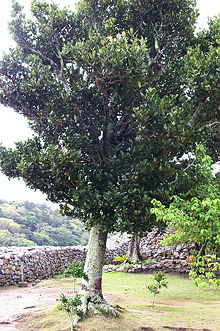| Garcinia | |
|---|---|

| |
| Garcinia subelliptica, the fukugi tree | |
| Scientific classification | |
| Kingdom: | Plantae |
| Clade: | Tracheophytes |
| Clade: | Angiosperms |
| Clade: | Eudicots |
| Clade: | Rosids |
| Order: | Malpighiales |
| Family: | Clusiaceae |
| Tribe: | Garcinieae |
| Genus: | Garcinia L. |
| Species | |
| Synonyms | |
| |
Garcinia is a genus of flowering plants in the family Clusiaceae native to Asia, America, Australia, tropical and southern Africa, and Polynesia. The number of species is disputed; Plants of the World Online (POWO) recognise up to 400.[1] Commonly, the plants in this genus are called saptrees, mangosteens (which may also refer specifically to Garcinia mangostana), or garcinias, and is one of several plants known as by the name "monkey fruit".
Many species are threatened by habitat destruction, and at least one species, G. cadelliana, from South Andaman Island, is almost or even completely extinct already.[2]
The fruits are a food source for several animals, such as the archduke butterflies (Lexias spp.) of tropical eastern Asia which relish the sap of overripe mangosteens.
The genus is named after French botanist Laurent Garcin (1683–1751).[3]
- ^ "Garcinia L." Plants of the World Online. Royal Botanical Gardens Kew. Retrieved 21 December 2018.
- ^ World Conservation Monitoring Centre (1998). "Garcinia cadelliana". IUCN Red List of Threatened Species. 1998: e.T33490A9782233. doi:10.2305/IUCN.UK.1998.RLTS.T33490A9782233.en. Retrieved 12 January 2018.
- ^ "Garcinia forbesii". www.nparks.gov.sg. Retrieved 23 January 2021.